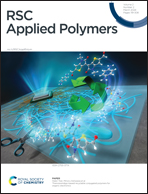Chemical recycling of bromine-terminated polymers synthesized by ATRP†
Abstract
Chemical recycling of polymers is one of the biggest challenges in materials science. Recently, remarkable achievements have been made by utilizing polymers prepared by controlled radical polymerization to trigger low-temperature depolymerization. However, in the case of atom transfer radical polymerization (ATRP), depolymerization has nearly exclusively focused on chlorine-terminated polymers, even though the overwhelming majority of polymeric materials synthesized with this method possess a bromine end-group. Herein, we report an efficient depolymerization strategy for bromine-terminated polymethacrylates which employs an inexpensive and environmentally friendly iron catalyst (FeBr2/L). The effect of various solvents and the concentration of metal salt and ligand on the depolymerization are judiciously explored and optimized, allowing for a depolymerization efficiency of up to 86% to be achieved in just 3 minutes. Notably, the versatility of this depolymerization is exemplified by its compatibility with chlorinated and non-chlorinated solvents, and both Fe(II) and Fe(III) salts. This work significantly expands the scope of ATRP materials compatible with depolymerization and creates many future opportunities in applications where the depolymerization of bromine-terminated polymers is desired.

- This article is part of the themed collections: Sustainable Development Goal 12: Responsible Production and Consumption and Editor’s Choice - Pengfei Cao


 Please wait while we load your content...
Please wait while we load your content...